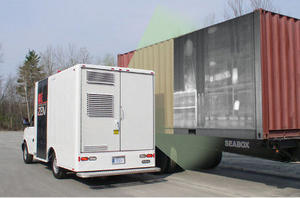Law-enforcement technologyDrive-by full-body scanning
Massachusetts-based American Science & Engineering is selling van-mounted backscatter X-ray detection system to law enforcement; these vans can be driven past neighboring vehicles to see their contents

Inspection with van mounted scanner // Source: defence.pk
As the privacy controversy around full-body security scans continues to grow, you should note that courthouses and airport security checkpoints are not the only places where backscatter X-ray vision is being deployed. The same technology, capable of seeing through clothes and walls, has also been rolling out on U.S. streets.
Joe Reiss, a vice president of marketing at Billerica, Massachusetts-based American Science & Engineering, told Andy Greenberg of Forbes that the company has sold U.S. and foreign government agencies more than 500 backscatter X-ray scanners mounted in vans. These vans can be driven past neighboring vehicles to see their contents. While the biggest buyer of AS&E’s machines over the last seven years has been the Department of Defense operations in Afghanistan and Iraq, Reiss says law enforcement agencies have also deployed the vans to search for vehicle-based bombs in the United States.
“This product is now the largest selling cargo and vehicle inspection system ever,” says Reiss.
The Z Backscatter Vans, or ZBVs, as the company calls them, bounce a narrow stream of X-rays off and through nearby objects, and read which ones come back. Absorbed rays indicate dense material such as steel. Scattered rays indicate less-dense objects that can include explosives, drugs, or human bodies. That capability makes them powerful tools for security, law enforcement, and border control.
Greenberg notes that it would also seem to make the vans mobile versions of the same scanning technique that has riled privacy advocates as it is been deployed in airports around the country. The Electronic Privacy Information Center (EPIC) is currently suing DHS to stop airport deployments of the backscatter scanners, which can reveal detailed images of human bodies.
“It’s no surprise that governments and vendors are very enthusiastic about [the vans],” says Marc Rotenberg, executive director of EPIC. “But from a privacy perspective, it’s one of the most intrusive technologies conceivable.”
AS&E’s Reiss counters privacy critics by pointing out that the ZBV scans do not capture nearly as much detail of human bodies as their airport counterparts. The company’s marketing materials say that its “primary purpose is to image vehicles and their contents,” and that “the system cannot be used to identify an individual, or the race, sex or age of the person.”
Reiss admits that the systems “to a large degree will penetrate clothing,” but he points to the lack of features in images of humans like the one shown at right, far less detail than is obtained from the airport scans. “From a privacy standpoint, I’m hard-pressed to see what the concern or objection could be,” he says.
EPIC’s Rotenberg is not persuaded, saying that the scans, like those in the airport, potentially violate the fourth amendment. “Without a warrant, the government doesn’t have a right to peer beneath your clothes without probable cause,” he says. Even airport scans are typically used only as a secondary security measure, he points out. “If the scans can only be used in exceptional cases in airports, the idea that they can be used routinely on city streets is a very hard argument to make.”
Reiss says that the vans do have the capability of storing images. “Sometimes customers need to save images for evidentiary reasons,” he says. “We do what our customers need.”
